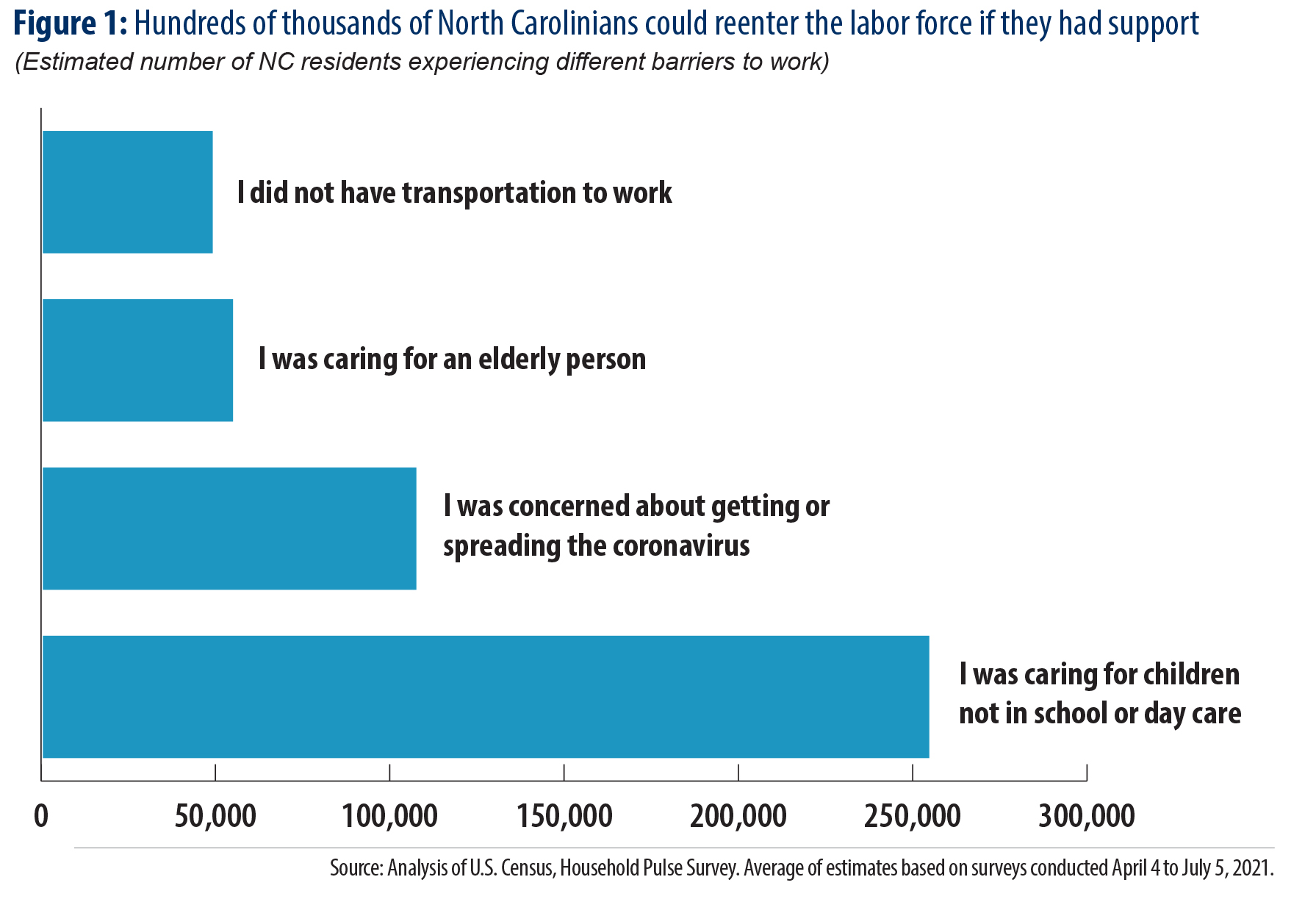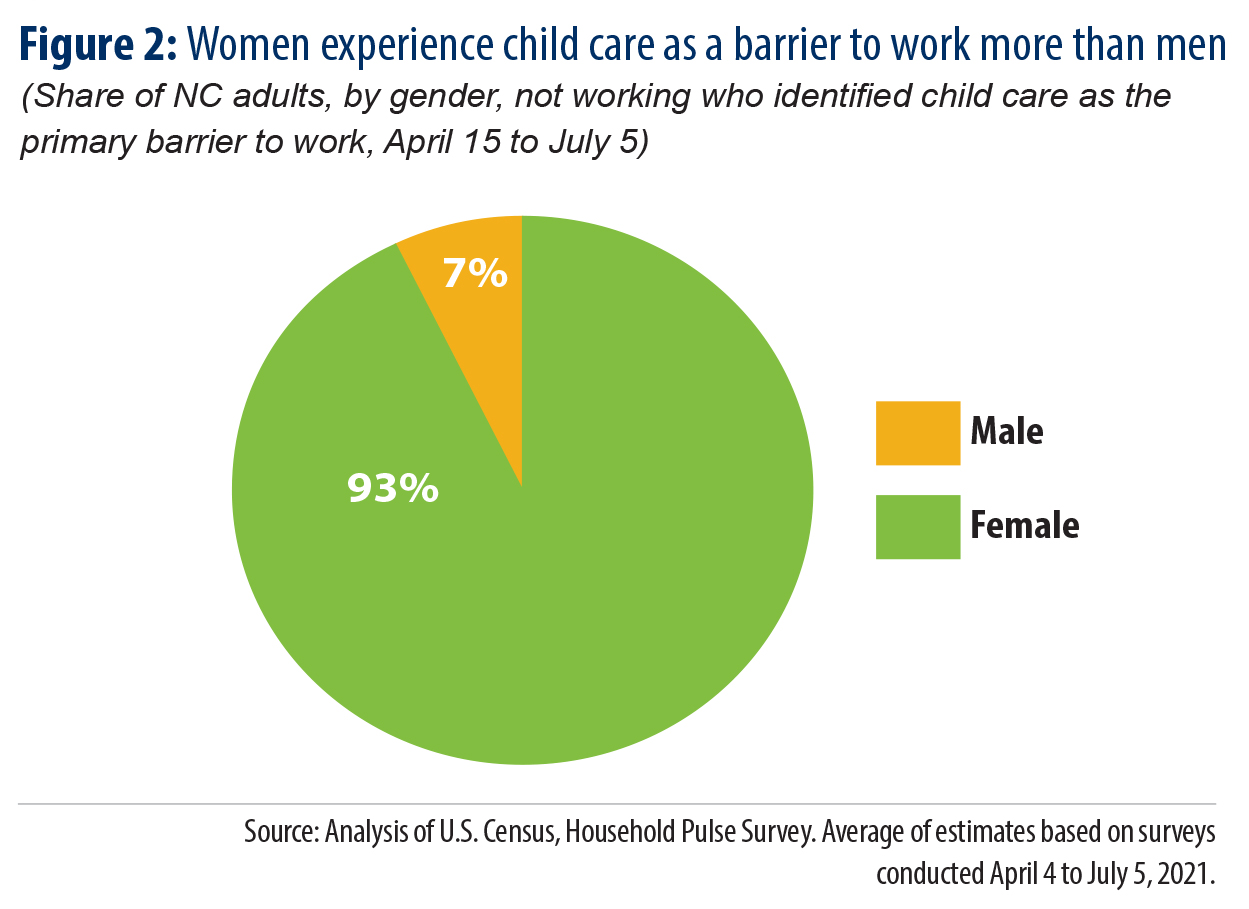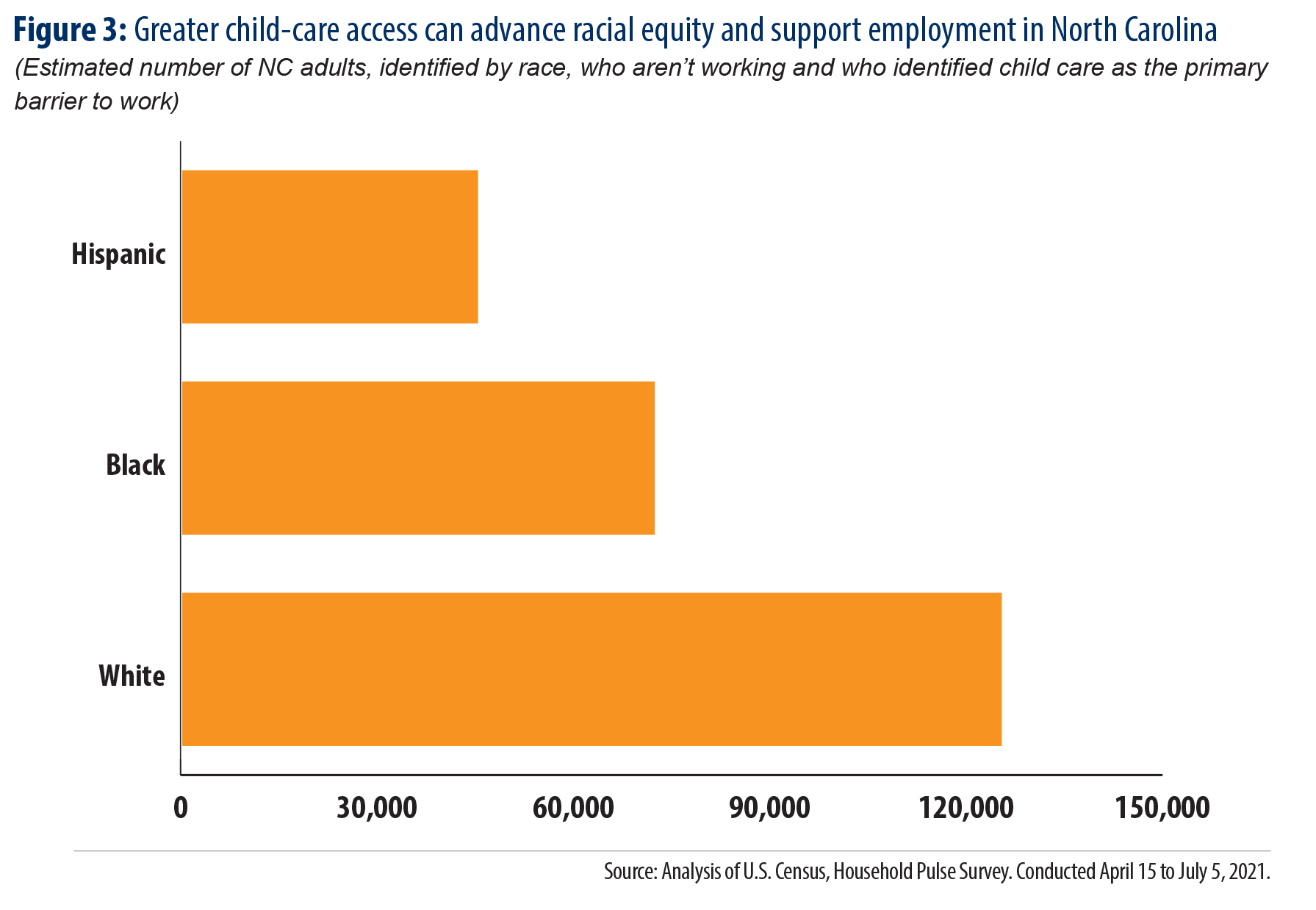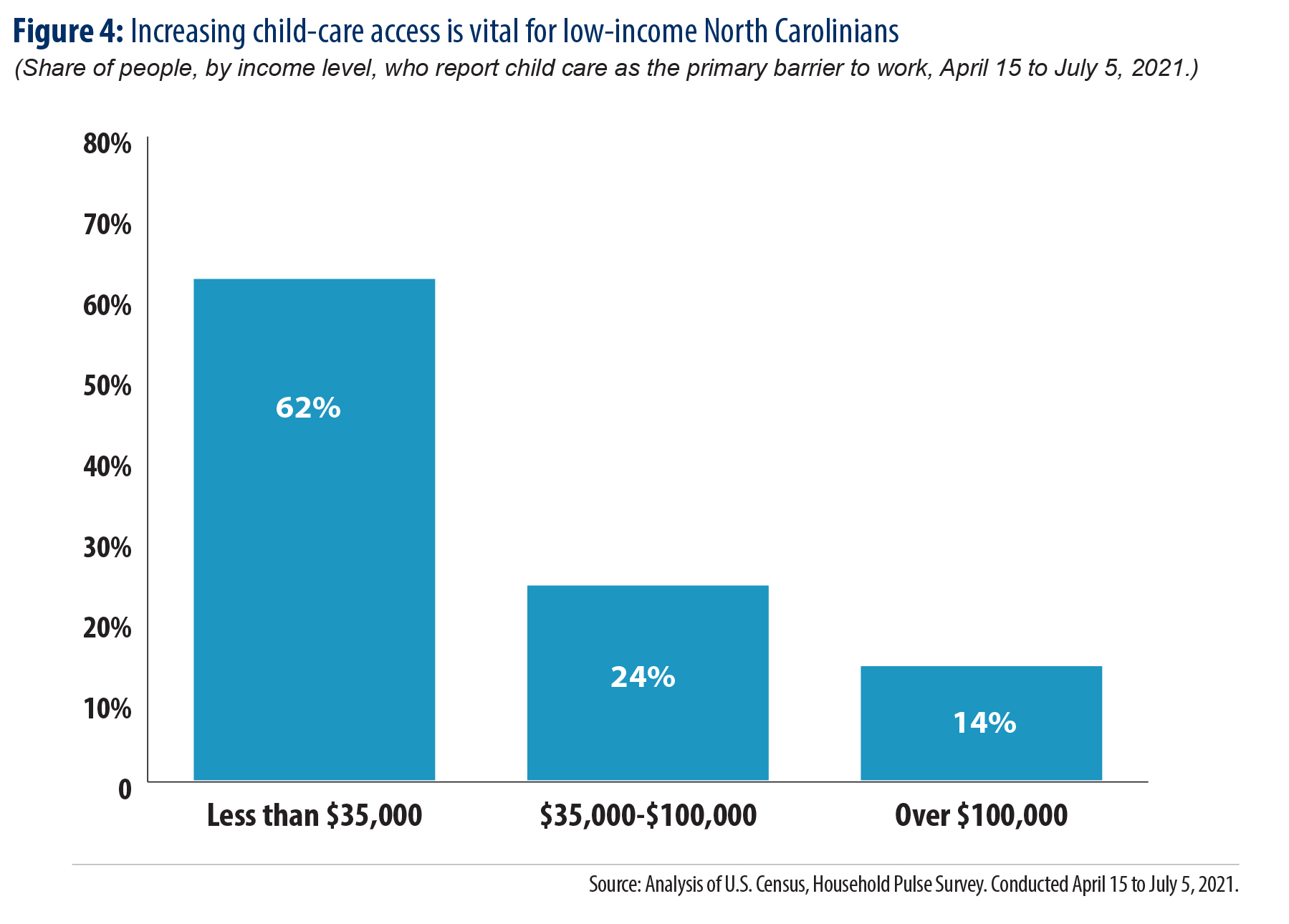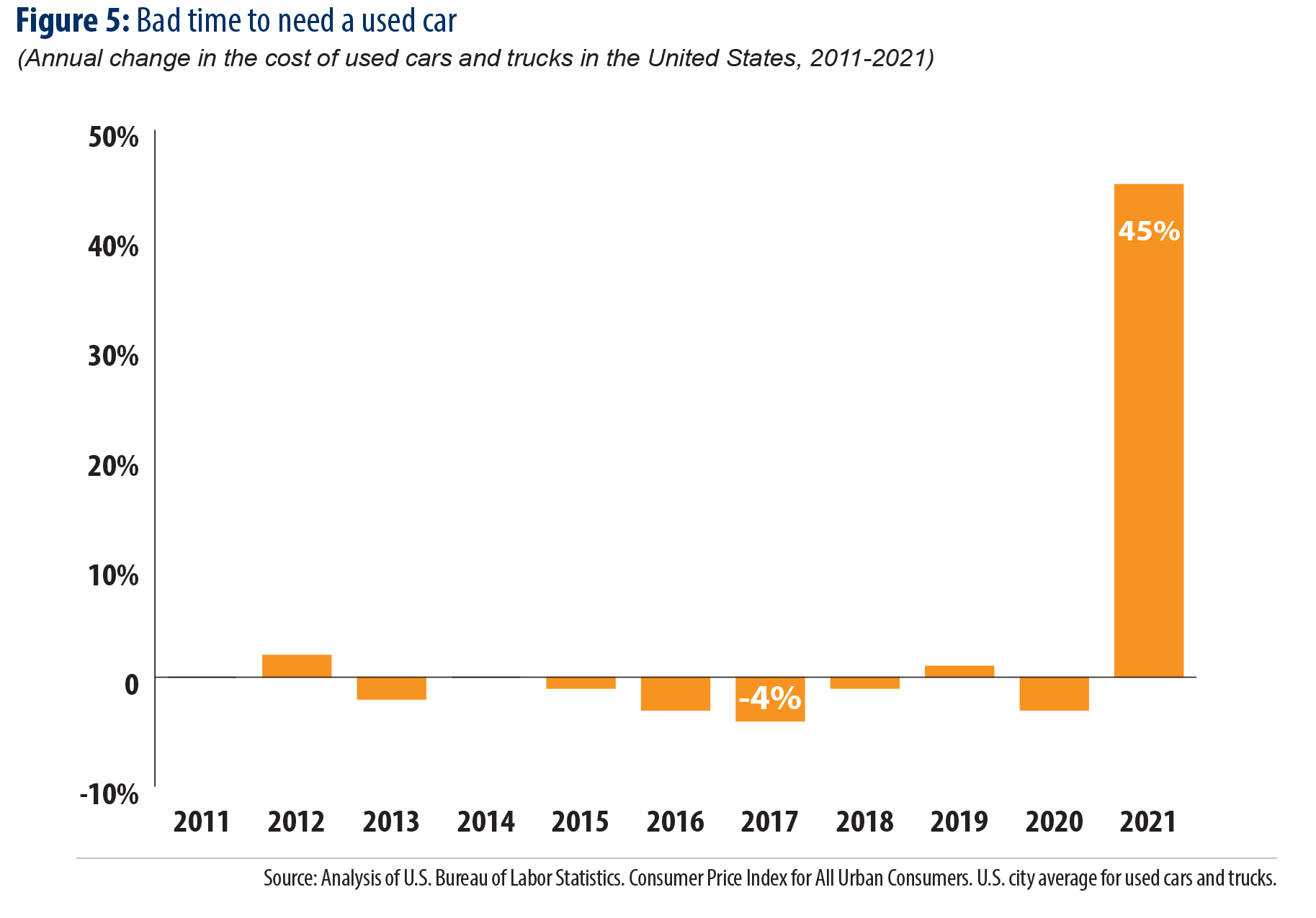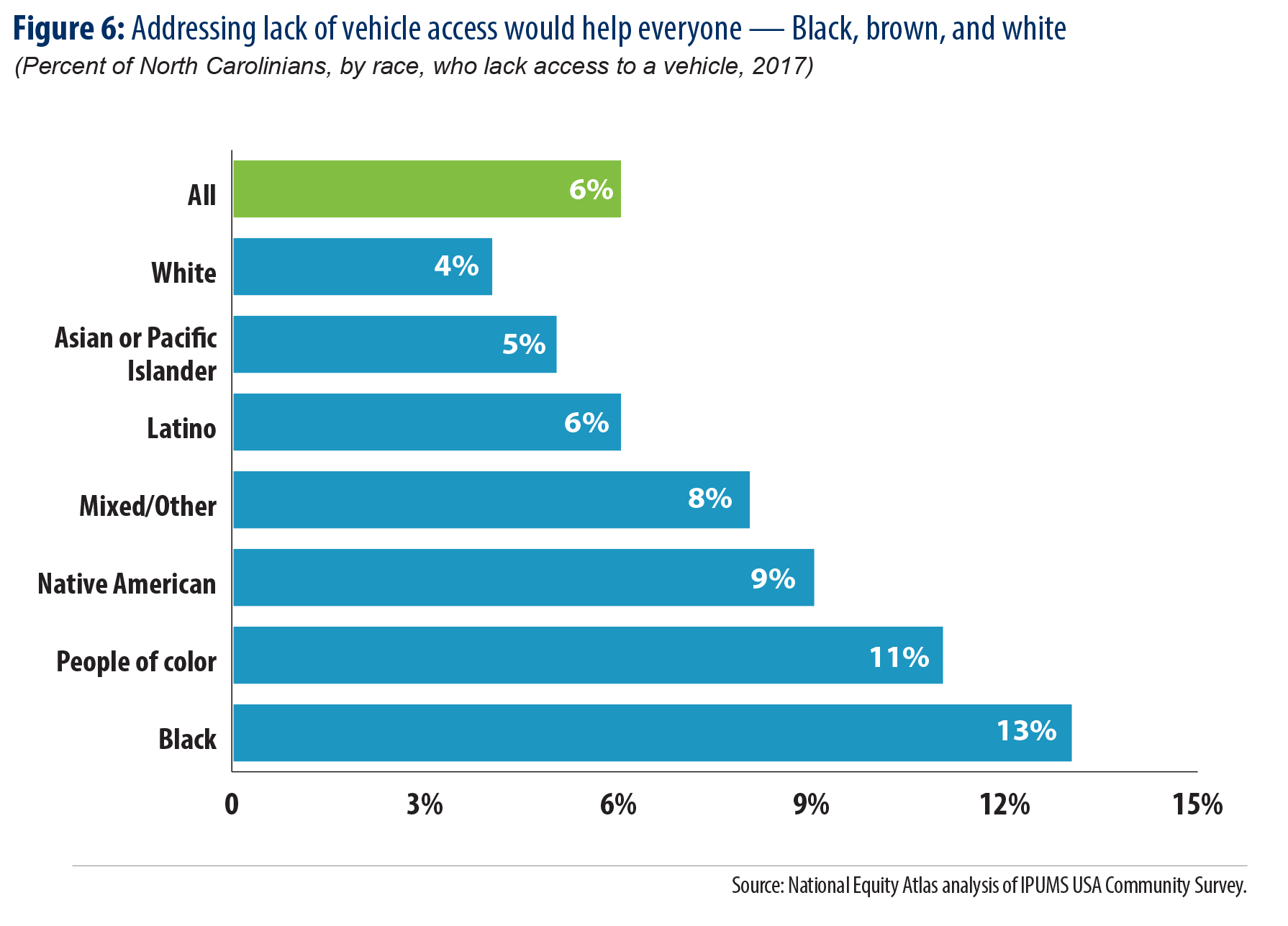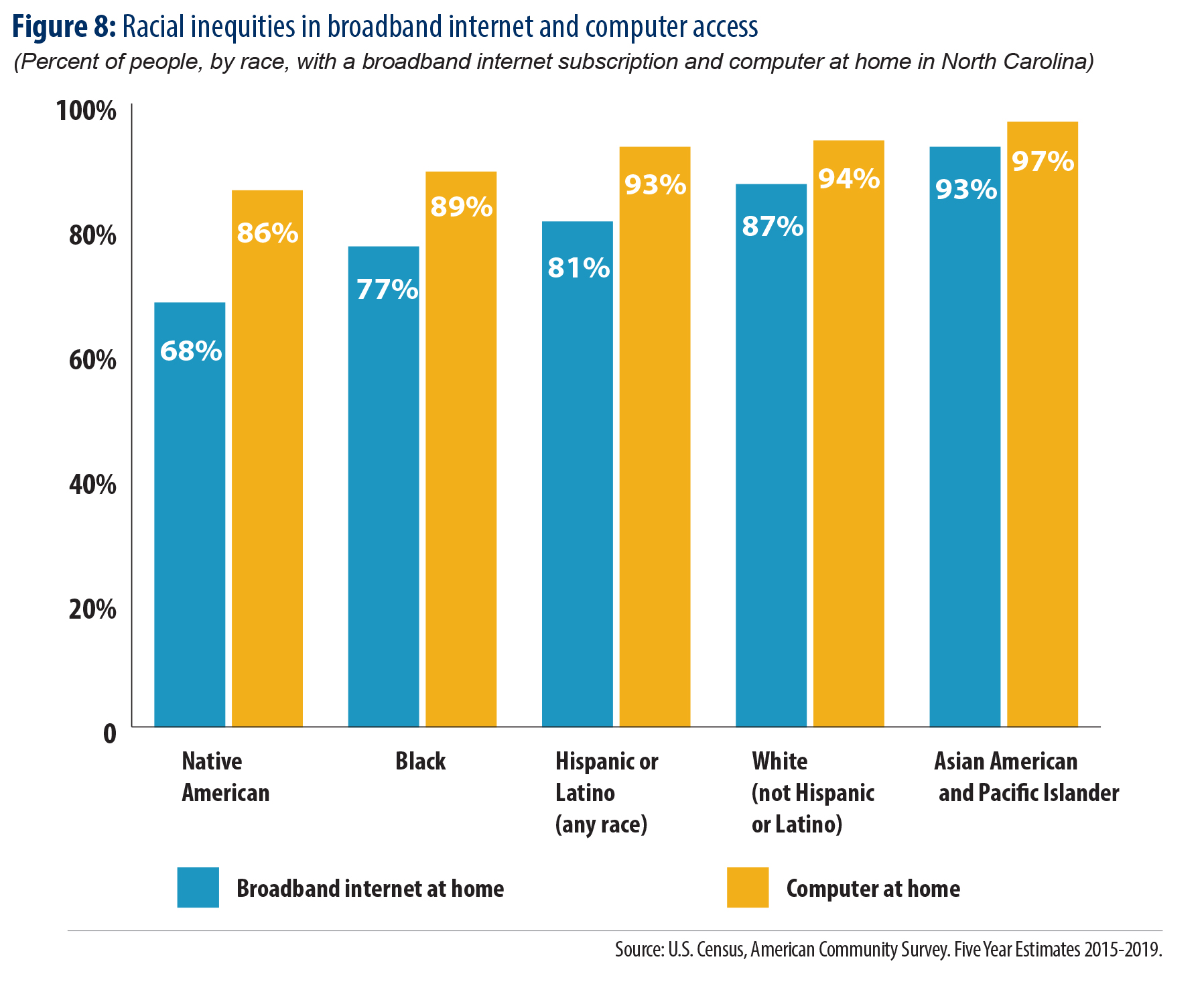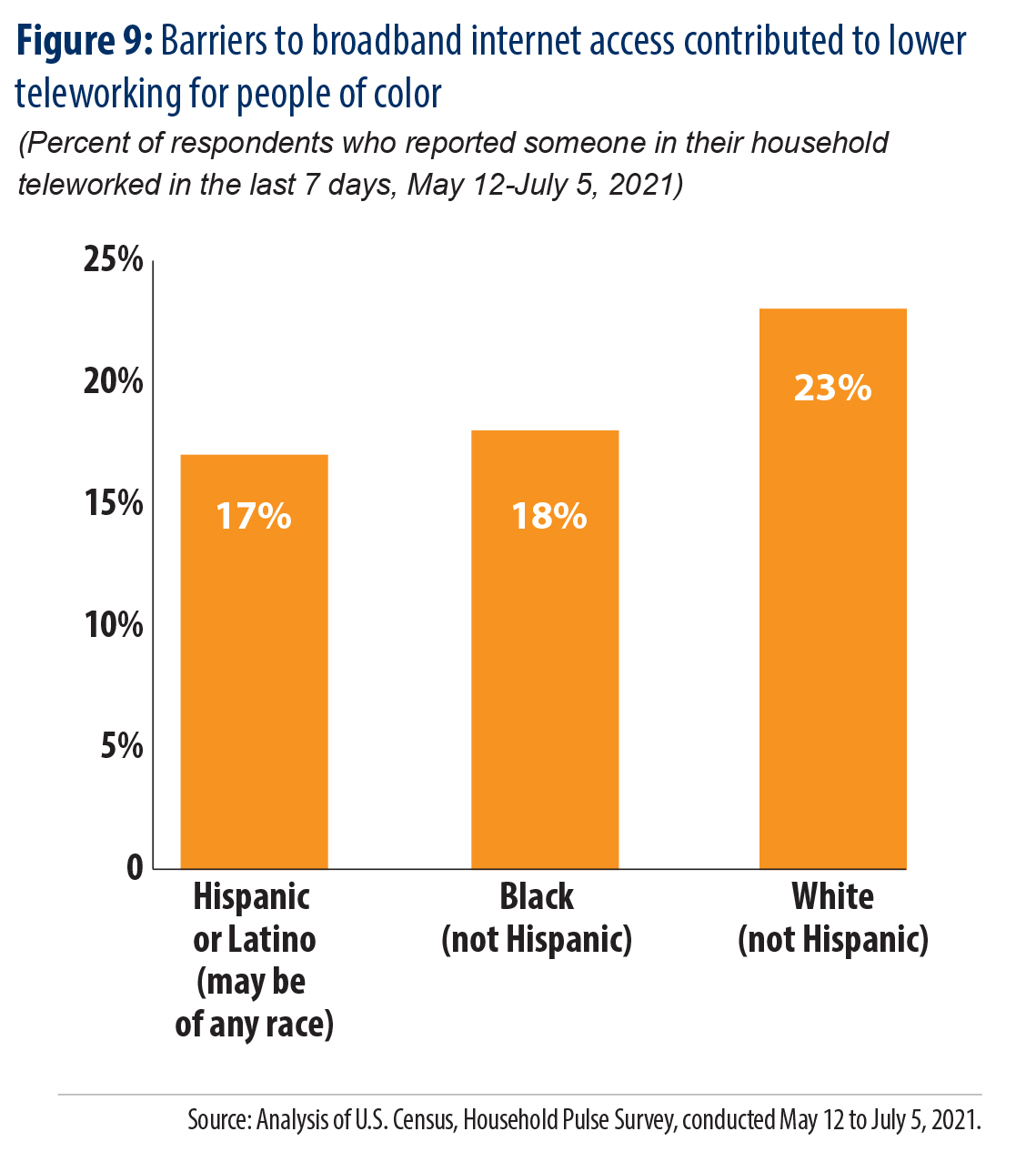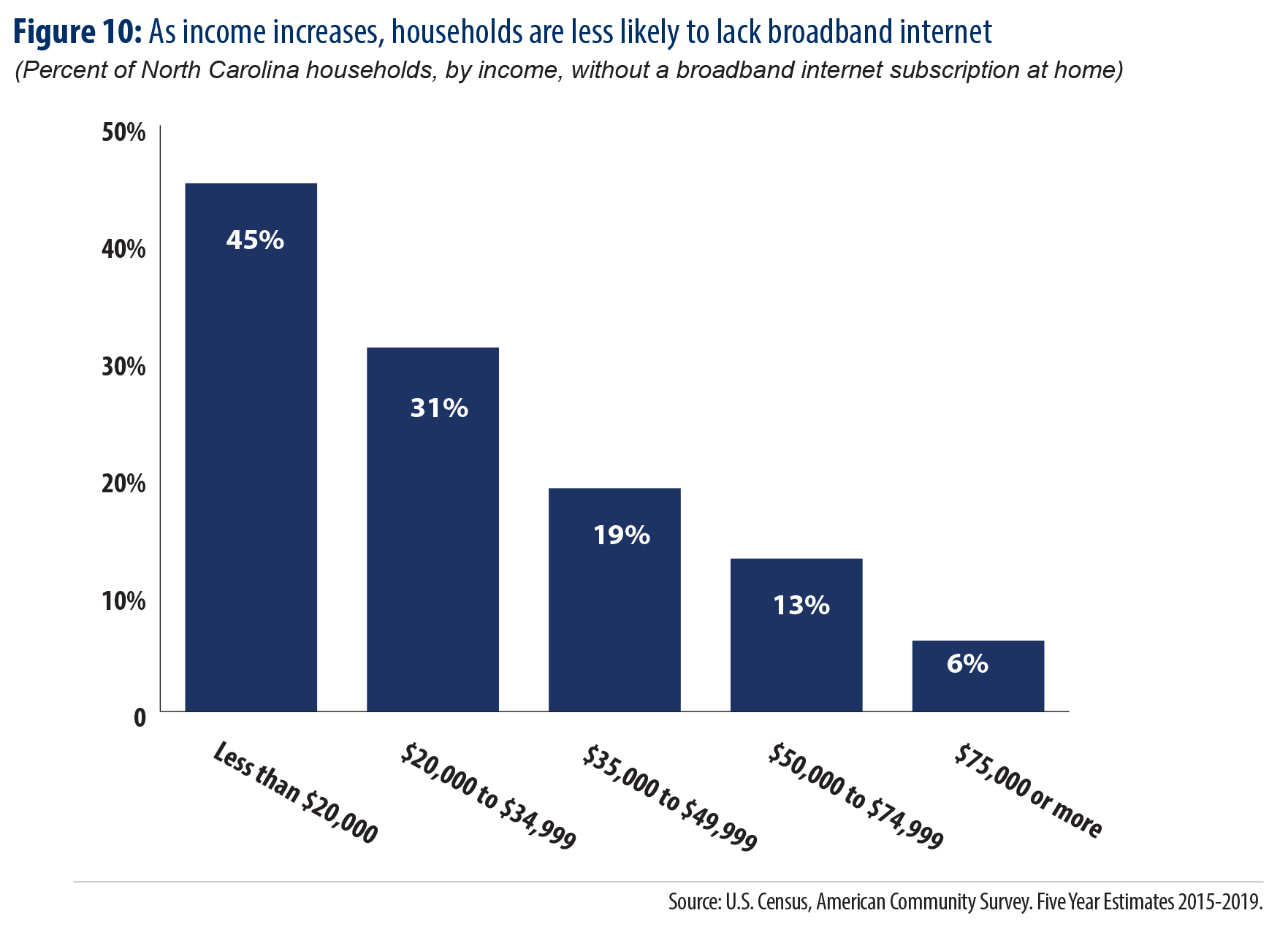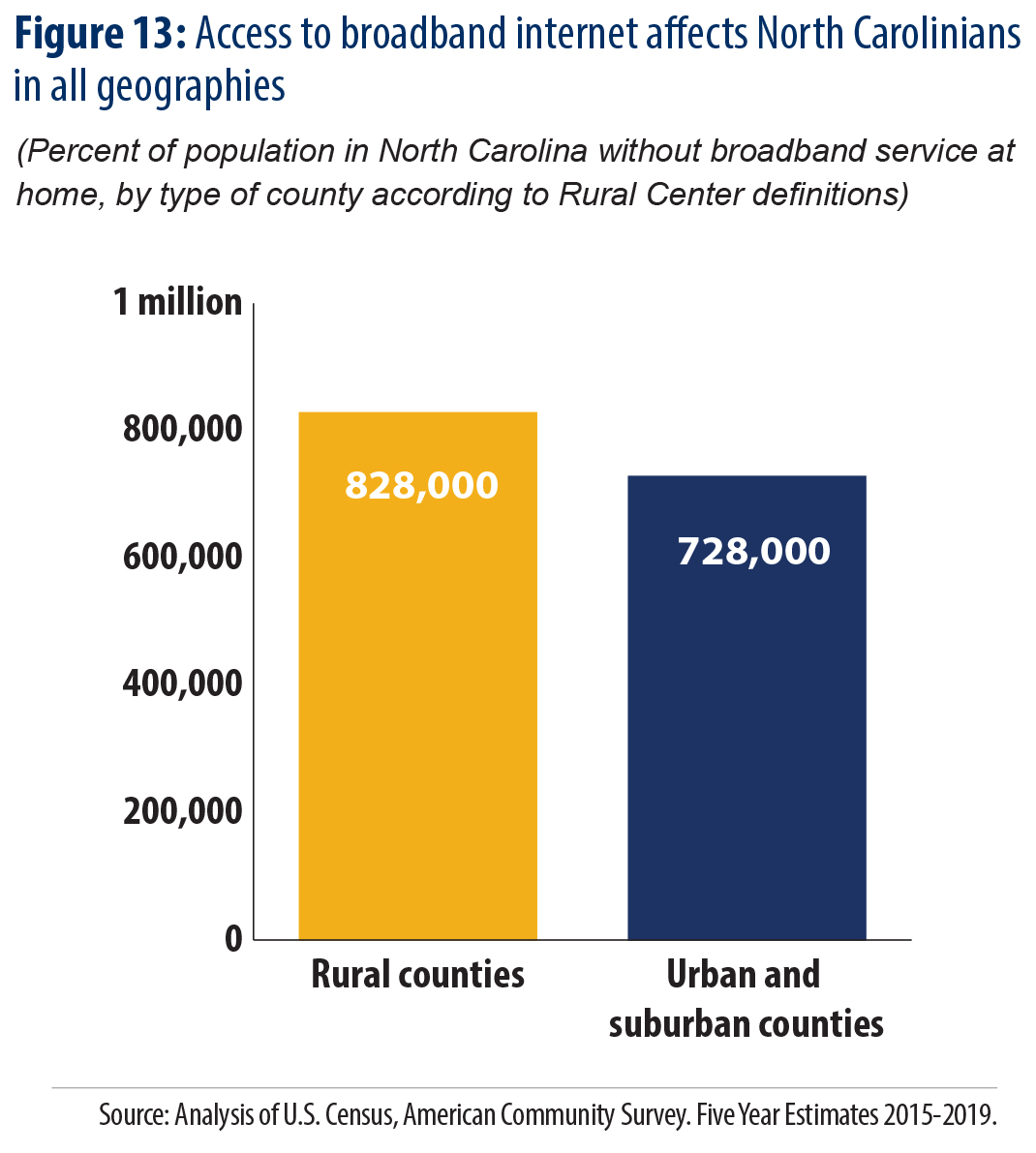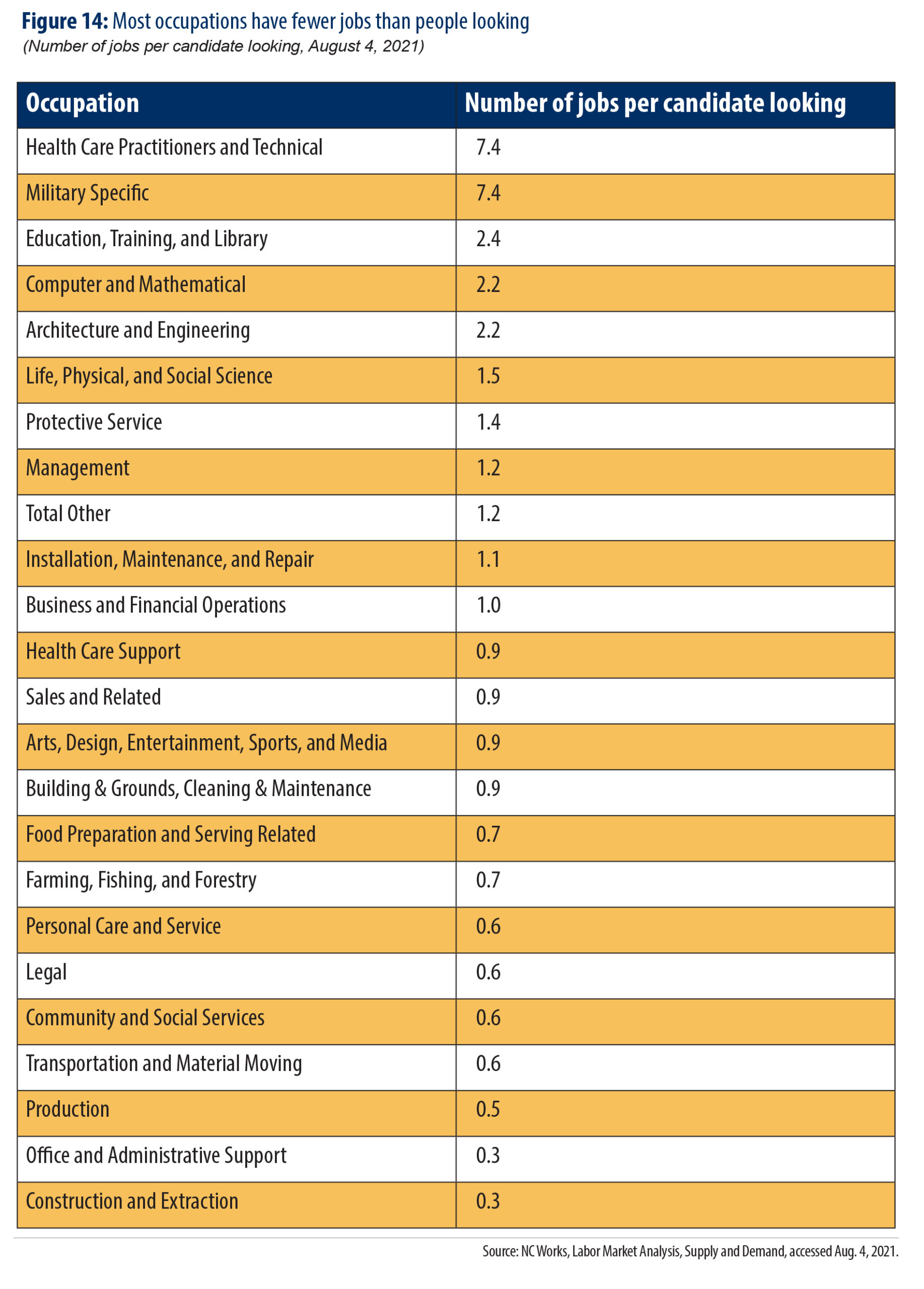It’s the best way for North Carolina to rebuild and move forward
Rebuilding from COVID-19 presents an opportunity to shore up our economic defenses and lift up communities that previously were left in harm’s way. Helping people overcome the barriers to rejoining the labor force is the quickest way to speed our collective economic recovery, and doing it right will put us on a path to a more resilient post-COVID economy. While not exhaustive, this report addresses some of the critical areas where helping workers will boost our economy in both the short and long run.
Creating access to affordable child care:
- Lack of child care presents the primary barrier to employment for around 70,000 Black, 45,00 Hispanic, and 125,000 white North Carolinians.
- In North Carolina, women are 10 times more likely than men to name caring for a child who was not in school or child care as the main reason they aren’t working.
- Around 100,000 people with incomes below $35,000 want to work but cannot because they have lacked child care in recent months.
Ensuring affordable transportation:
- An estimated 50,000 North Carolinians experience a lack of transportation as the primary barrier to their ability to work.
- The price of a used vehicle has increased by over 40 percent compared with 2020.
- Roughly 105,000 white households lacked access to a vehicle in 2017, a figure almost identical to the number of Black households facing the same problem.
Protecting workers on the job:
- More than 100,000 North Carolinians would be willing to enter the labor force if they felt secure from contracting or passing on COVID-19.
- Universal access to paid sick leave could have averted thousands of COVID-19 cases in North Carolina per week during some periods of the pandemic.
Connecting workers to the digital world:
- Lack of access to broadband internet and home computers perpetuates racial economic inequalities.
- Roughly 45 percent of North Carolina households with incomes below $20,000 do not have a broadband internet subscription at home.
- Lack of broadband access is not just a rural problem. Nearly 830,000 residents of rural counties and 730,000 residents of urban and suburban counties lack access to broadband internet.
Connecting workers to new careers:
- Around 165,000 North Carolinians retired in recent months, increasing the need to train younger workers for the jobs they are leaving behind.
- The occupations with the greatest labor shortage require extensive training and specialized skills.
- The mismatch between workers’ existing skills and the needs of employers is greatest in many rural counties.
COVID-19 — a storm that teaches
Years ago, a traveling salesman was stuck outside in a thunderstorm, miles from the nearest town. At the next house he came to, a man was standing in the door watching the rain pour. The salesman walked up and asked whether he might be able to stay the night while the storm passed.
“Well,” the man replied, “the only place I’ve got is in the kitchen, and the roof leaks so bad in there you’d get just as wet as staying out here.”
Taken aback, the salesman asked, “Why don’t you fix the roof?”
“Are you crazy?” the man replied. “It’s raining out here!”
“Of course, I don’t mean now,” the frustrated salesman retorted. “Why don’t you fix it when it isn’t raining?”
“Because then it isn’t leaking.”
There’s some wisdom in that old country yarn about where North Carolina was when COVID-19 arrived. Our state government is like the roof in the story. We have been through the longest period of uninterrupted economic growth in generations, but leaders allowed our shared home to fall into disrepair. As soon as the storm started, it became even more painfully evident how years of neglect had left our public institutions unable to cope with a crisis.
We also have allowed an economic order to evolve that left far too many families with little or no shelter of their own to fall back on. Big corporations and the ultra-rich did just fine in the wake of the Great Recession, but most families and working people in North Carolina didn’t have the savings to survive without work or income when the pandemic closed businesses across the state. Like the traveling salesman, millions of North Carolinians were left out in the storm with little shelter in sight. Federal aid did provide vital assistance, but the lack of infrastructure to support families in crisis here in North Carolina has created needless financial pain and delayed the pace of our recovery.
Our lack of a robust safety net is now hampering North Carolina’s recovery from the pandemic. Hundreds of thousands of people who would like to work still face barriers in returning to work, preventing businesses that are trying to hire from staffing up as quickly as they would like.
Whether we’re talking about building a roof or building our economy, the lesson is the same: Build for the bad times when it isn’t raining.
States with better safety nets have bounced back faster
COVID-19 set off an instructive, if unwanted, experiment. The massive loss of jobs in the early weeks of the pandemic created an unprecedented spike in Unemployment Insurance (UI) claims nationwide. Different experiences across states underscore the economic importance of supporting people financially when they lose jobs through no fault of their own. States with more generous Unemployment Insurance programs generally experienced milder employment declines and quicker recoveries during the first months of the pandemic.[1] In states with less adequate UI benefits, a stronger negative feedback cycle was created as the loss of income depressed consumer spending and prevented businesses from hiring again.
Hundreds of thousands of North Carolinians can be reconnected with the labor force
Even in the best of times, there’s no perfect way to capture the full range of barriers that can stand between a willing worker and a job, and the shock of COVID-19 makes that challenge even worse. It’s also difficult to truly identify the most common reasons for a person to leave the workforce; often a crisis in one part of a person’s life leads to accumulating challenges that frustrate their ability to find a job. For people experiencing poverty, something like a car breakdown can quickly lead to losing a job, being unable to pay rent, going hungry, running up credit card bills, and a domino effect of negative outcomes that would never happen to someone with more financial resources.
Although there are complex reasons a person may be unable to find work, there are some common issues that have been tracked during COVID-19. Surveys by the U.S. Census estimate that around 250,000 North Carolinians experience a lack of child care as the most dramatic impediment to working, 100,000 residents are concerned about contracting or spreading COVID-19, and 50,000 are prevented from working primarily because they lack transportation or provide care for an elderly person. Again, each of these statistics almost certainly undercounts the impact of these barriers because many North Carolinians experience multiple obstacles, but the survey asked for the primary reason they were unable to work.
Here’s the good news — these are problems that can be fixed. States such as Vermont, Oklahoma, and Washington have experimented with a range of supports, including enhanced access to affordable child care and direct financial incentives for returning to work.[2] Helping people overcome barriers to employment isn’t rocket science; it’s simply a question of devoting resources to solving the problem. With employers across our state clamoring for more workers, helping people overcome the barriers preventing them from working is the best way to boost our economy.
Census effort to assess hardship
This report relies heavily (but not exclusively) on a set of surveys conducted throughout the pandemic by the U.S. Census. The Household Pulse Survey is an effort to assess the hardship created by COVID-19 and provides a unique window into the barriers preventing people from working. Like any survey, this tool is not perfect. First, it can only estimate the number of North Carolinians who experience different barriers to work. To make the estimates more reliable, all of the analysis presented here is based on the average of surveys conducted between April 4, 2021, and July 5, 2021. Second, the survey wording asks people to identify the primary reason they are not able to work in a given week. Because people often experience more than one barrier, the estimates are almost certainly undercounted. Finally, some barriers are not included in the survey, like a lack of housing or food, so there is no way to incorporate the full range of challenges that prevent people from working. Nevertheless, the Household Pulse tool does provide a useful picture of why many North Carolinians have struggled to stay connected to the labor market throughout the COVID-19 pandemic.
Solving child-care barriers
The COVID-19 pandemic has thrown the connection between child care, employment, and gender equity into sharp relief. Yet the availability of affordable and high quality child care has always been a key support for working parents — and specifically mothers — of young children. Women’s participation in the labor force has grown by 70 percent since 1950, but women have continued to take on most of the care work in their families.[3] Nationwide, mothers who have no difficulty finding a child-care program that works for their family are significantly more likely to be employed.[4] Public spending on child-care subsidies, which help cover the costs of licensed child care for families with low incomes, is associated with higher employment rates among low-income mothers.[5]
Child care doesn’t just support parents’ employment overall; it also affects their ability to work sufficient hours, seek promotions, and build skills. A recent report from the NC Early Childhood Foundation found that before the pandemic, about 1 in 3 parents of a child under 5 reduced their work hours due to child-care problems, while 1 in 5 parents turned down a promotion.[6] One in 5 parents of young children also reported dropping out of a college or training program due to child-care problems, highlighting the importance of accessible child care for parents to advance in their careers.[7] One survey from 2016 found that about 63,000 parents in North Carolina quit a job, didn’t take a job, or greatly changed their job because of child-care problems.[8] With low-wage workers increasingly working non-standard and unpredictable hours, finding reliable formal child care can be an even greater challenge. In North Carolina, nearly 3 out of 5 children under 6 years old with working parents in low-income families have parents who work non-standard hours at least some of the time.[9]
Currently, North Carolina doesn’t ensure that families have access to child-care options that support high quality employment and career advancement for parents of young kids. While an estimated 226,000 children ages 0-5 are eligible for publicly funded child-care assistance, only an estimated 17 percent receive assistance.[10] In many parts of the state, particularly rural areas, there simply aren’t sufficient openings in licensed-child care providers to serve all young children: An estimated 44 percent of the state’s children under 6 live in these “child care deserts.”[11]
Unpaid care responsibilities include elder care
In addition to people who are not working because they are caring for children, about 54,000 North Carolinians, nearly two-thirds of them women, report that the primary reason they aren’t working is that they are caring for an elderly person. As more members of the baby boomer generation age into needing care, these responsibilities will only increase and put more workers in the role of “sandwich” caregivers who care for both their children and parents.
The pandemic has highlighted the connections between child care and parents’ work
Licensed child-care providers in North Carolina are an essential business, and many providers continued to operate throughout the COVID-19 pandemic, albeit under intense stress and disruption. While many providers closed temporarily following the emergency declarations, in July 2021 the number of open providers across the state was about 90 percent of the number in February 2020. But even providers that have stayed in business continue to face periodic closures as they adopt and adjust safety protocols and deal with unstable enrollment. For parents, widespread school closures meant greater child care demands than ever, while job loss, income instability, and uncertain and uneven availability made access to child care incredibly challenging for many families.
Statewide, 8 percent of people who weren’t working said that caring for a child who wasn’t in child care or school was their primary reason, based on surveys conducted from April 15 to July 5, 2021. This is a total of at least 250,000 people who need greater access to affordable child care to connect to the labor market — the true number is likely much higher, as child care is a factor in the ability to work even for people who don’t select it as the primary reason.
Addressing child care can boost racial and gender employment equity in North Carolina
Women have continued to do a majority of child care labor during the pandemic, as COVID-19 has reinforced long-standing patterns of inequity. In North Carolina, women are 10 times more likely than men to name caring for a child who was not in school or child care as the main reason they aren’t working. Increased access to affordable child care would have reduced this barrier for approximately 235,000 women and many more people for whom child-care needs may be secondary barriers to work. The disproportionate child care responsibilities that women have taken on have contributed to what economists are calling the first “female recession” in the United States.[12] Figure 2 shows that in North Carolina, women are 93 percent of the people who name caring for a child as the main reason they aren’t working.
Availability and cost barriers fall more heavily on workers of color in North Carolina than their white colleagues. U.S. Census surveys conducted between April 15 and
July 5 indicate that lack of child care presents the primary barrier to employment for around 70,000 Black, 45,00 Hispanic, and 125,000 white North Carolinians, as shown in Figure 3.
While the sheer number of white workers who would benefit from increased access to affordable child care is larger than either Black or Hispanic workers, eliminating this barrier would make North Carolina far more equitable. While 70 percent of North Carolina’s population is white, white potential workers make up less than 50 percent of the people who report child care as the largest barrier to work. Conversely, Black and Hispanic workers account for a larger share of the people who are prevented from working because of child care than their overall representation in North Carolina’s population. Helping everyone — Black, brown, and white — is the best way to create a more equitable economy.
Increasing access to affordable child care would also provide a vital boost to North Carolina families with the lowest incomes. Figure 4 shows that about 3 in 5 people who weren’t working due to child care have household incomes under $35,000. Around 100,000 people with incomes below $35,000 want to work but cannot because they have lacked child care in recent months, compared to less than 40,000 who earn between $35,000 and $100,000.
To support working parents, invest in early childhood educators
A key part of the equation for getting families the high quality child care they need is public investment in compensation for child-care workers. North Carolina’s child-care workers earn on average less than $11 per hour, often with no benefits, for their extremely valuable and challenging work. The result is that licensed child-care programs struggle to hire and retain staff and that even as program enrollment increases, staffing is a limiting factor in how many children programs can serve.
Solving transportation barriers
Solving transportation barriers could go a long way toward speeding the recovery and making North Carolina more economically resilient. Tens of thousands of North Carolinians currently cannot work because they lack reliable transportation, a trend that has been exacerbated by COVID-19 but certainly did not start with the onset of the pandemic.
The rising cost of living in many of North Carolina’s growing cities has pushed low-wage workers farther away from where jobs exist. Nationwide, the average one-way commute time has grown every year since the Great Recession[13] and this trend has not spared North Carolina. The average one-way commute time in both Raleigh and Charlotte is now more than 27 minutes and is significantly higher for many low-wage workers who cannot afford to live near the bustling job centers. As the average commute grows, access to reliable transportation becomes increasingly critical.
Addressing transportation needs can reconnect many to labor market
Solving transportation barriers could reconnect tens of thousands of North Carolinians to the labor market. U.S. Census surveys conducted between April 15 and July 5, 2021, indicate an estimated 50,000 North Carolinians experience a lack of transportation as the primary barrier to their ability to work. While this figure is impressive enough, it doesn’t fully capture the benefits of increasing transportation equity. Many people who want to work face multiple barriers, often rooted in the same underlying economic reality, so transportation poses a challenge for far more North Carolinians than would have been captured by this survey alone.
Experiment worth replicating: fare-free transit
If necessity is the mother of invention, COVID-19 could leave behind an unexpected positive descendant. As the pandemic created enormous financial hardship and a public health risk in passing paper money, many municipalities experimented with waiving public transit fares. Raleigh is one place where this experiment is playing out, demonstrating the potential benefits of making this kind of policy permanent. As David Meeker, a fare-free advocate and brewery owner, observed, “You are giving every person who can’t afford a car $50 a month. That’s 600 bucks a year, and for a lot of people, that’s a month’s rent.”[14]
Exploding cost of used vehicles is hampering the recovery
Families who lost jobs and income during COVID-19 face a particular challenge if they need a car to get back to work. Along with many basic necessities like food, used vehicle prices have jumped dramatically during the pandemic. After trending down for most of the past decade, the inflation-adjusted cost of a used vehicle in the United States has exploded in the past few months.
The average used vehicle cost almost one-third more in June 2021 than a decade ago. While government policies like eviction moratoria have helped many families that lost income during the pandemic, relatively little support has been made available for people who could not afford car payments during COVID-19 but need transportation to rejoin the labor market.
Addressing vehicle access would boost equity, help people of all races
Like many structural roots of poverty, lack of vehicle access creates a harmful feedback loop that captures people of color at higher rates. Census data indicate that Black households are more likely than any other racial group to lack access to a vehicle, a rate that is more than three times higher than white households. While the gap is not as wide across the board, addressing the lack of vehicle access would play an important role in creating a more equitable economic landscape in North Carolina.
While a larger share of households of color would benefit from reducing barriers to vehicle access, there are nearly as many white households who face this barrier to economic opportunity. Roughly 105,000 white households lacked access to a vehicle in 2017, a figure almost identical to the number of Black households facing the same problem, each making up around 45 percent of the total statewide.
Ensuring safe workplaces and practices
Protecting workers and building a sustainable economic engine go hand in hand. The experience of COVID-19 has provided a tragic reminder of what happens when workers are forced into dangerous working conditions. But it also can show us a path to a better future.
A variety of workplaces with lax protections have fueled the COVID-19 outbreak, with significant cases and deaths associated with workplaces like meat-packing plants and independent living facilities.[15] We still do not have a full accounting of how many COVID clusters were driven by workplace exposure, particularly in industries where a significant portion of the working people are part of communities where undocumented status is common. Farmworker camps, for example, continue to experience significant COVID-19 infections, but the documented cases almost certainly understate the severity of the problem because people may not seek treatment.
The past year of the pandemic has been all too full of avoidable tragedy; some lessons can shape a more worker-friendly, humane, and resilient economy going forward.
Paid sick days have kept people safe and limited the spread of COVID-19
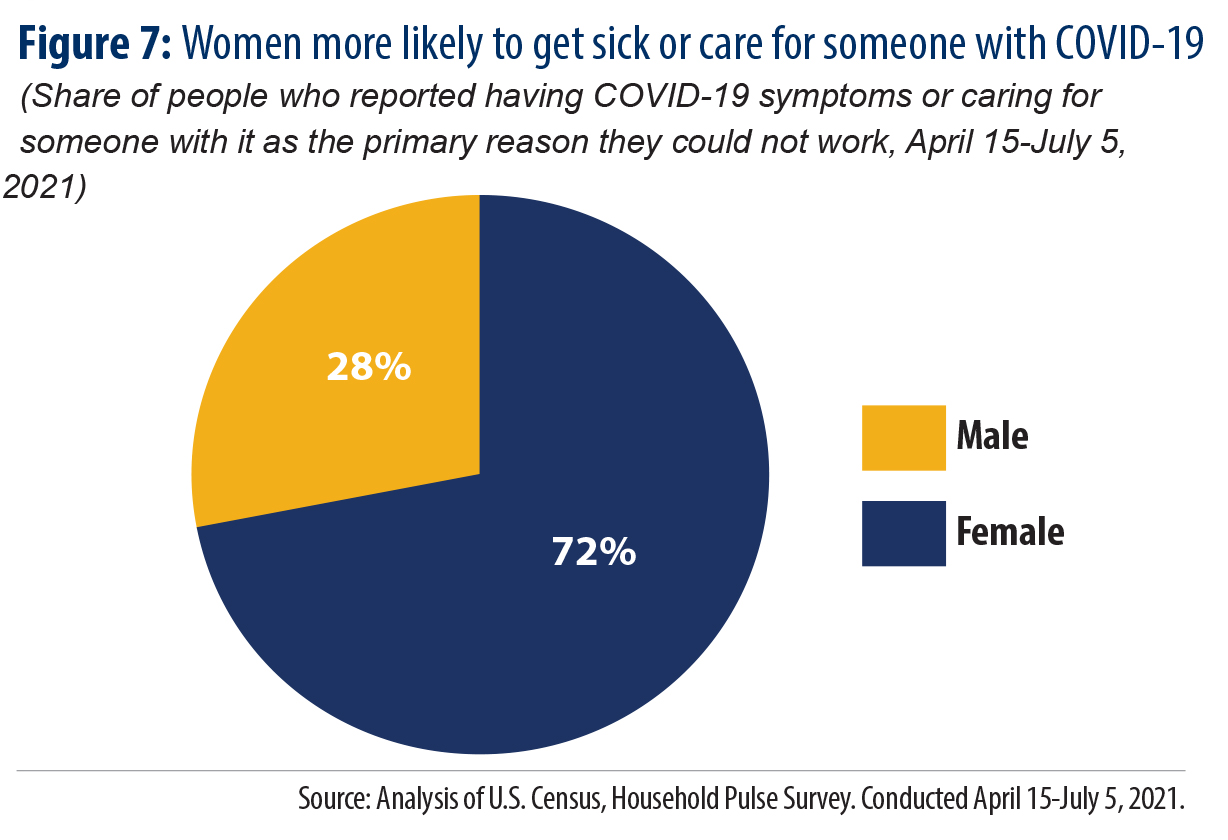 COVID-19 has dramatically demonstrated the life-saving importance of paid sick days. Millions of North Carolinians are forced — by company practice and financial necessity — to continue working when they are sick or have a family member who is. Throughout COVID-19, working North Carolinians have raised the alarm about visibly ill coworkers coming to work. Many people were essentially forced to go to work when they were sick or had been exposed by caring for an ill family member because they could not afford to lose even a few shifts worth of income or because they were threatened with being fired if they did not show up.
COVID-19 has dramatically demonstrated the life-saving importance of paid sick days. Millions of North Carolinians are forced — by company practice and financial necessity — to continue working when they are sick or have a family member who is. Throughout COVID-19, working North Carolinians have raised the alarm about visibly ill coworkers coming to work. Many people were essentially forced to go to work when they were sick or had been exposed by caring for an ill family member because they could not afford to lose even a few shifts worth of income or because they were threatened with being fired if they did not show up.
Workers who gained access to paid sick leave from the Families First Coronavirus Relief Act (FFCRA) were less likely to get sick, which in turn helped to reduce community spread during many phases of the pandemic. Analysis of COVID cases for workers who gained paid sick leave protections from the FFCRA indicates “roughly one prevented case per day per 1,300 workers who had newly gained the option to take up to two weeks of paid sick leave.”[16]
The health and welfare benefits could have been even further-reaching if the FFCRA had covered every worker in North Carolina. Exemptions in the FFCRA for large employers, first responders, and some other businesses kept more than 3 million North Carolinians — disproportionately workers of color — in frontline industries, from the protections of paid sick leave.[17] Given the demonstrated impact of paid sick days in preventing spread, universal access to paid sick leave could have averted thousands of cases in North Carolina per week during some periods of the pandemic.
Paid sick days would boost gender equity
Expanding access to paid sick leave would particularly benefit female workers and the family members they care for. Like child care, elder care, and other forms of largely unpaid caregiving, women are much more likely to provide care for family members who get COVID-19 or to get sick themselves.
Surveys conducted between mid-April and early July 2021 indicated that an average of roughly 40,000 women in North Carolina were unable to work each week because either they had COVID-19 or were caring for someone who was fighting to recover from the disease. With fewer than 15,000 men reporting the same experience, women made up approximately 70 percent of the North Carolinians who were either sick or caring for a loved one.
Safe workplaces are key to economic resilience
Robust workplace safety regulations and oversight are the foundation for viable economies. The experience of COVID-19 provides a dramatic new demonstration of how protecting workers protects our collective economic fortunes.
Surveys conducted between April 2021 and July 2021 indicate more than 100,000 North Carolinians would be willing to enter the labor force if they felt secure from contracting or passing on COVID-19.[18] The unfortunate reality is the North Carolina Department of Labor has not developed robust regulations and oversight to ensure that people feel comfortable returning to their places of employment, particularly in many frontline industries, like customer service, that require interacting with significant numbers of people each day. Now with the Delta variant driving a resurgent wave of infections, we’re being reminded again that protecting working people is good for the economy and failing to do so makes our recovery less sustainable.
COVID-19 a ‘black elephant’ event
Some workforce experts see COVID-19 as a “black elephant” event — the combination of a black swan event (something rare or unforeseen with dire consequences) and the elephant in the room (a problem everyone knows about but doesn’t want to talk about). The pandemic was not predicted, but by accelerating shifts in the labor market that make it hard for people to move between jobs, the pandemic has worsened a problem we already had.
Digital connections
High-speed internet is now an essential utility, and the COVID-19 pandemic has revealed just how necessary equitable internet access is for an equitable economy. While the shift to remote schooling for millions of secondary and college students have made home internet and computer access crucial for education, digital inclusion is also closely connected to employment and labor markets.
People now need to use the internet to apply to most jobs, and high-speed internet at home means people are better able to search for jobs, contact potential employers, and create professional documents like resumes.[19] Having a computer — rather than only a smartphone — is often important as well, as many online applications are challenging, if not impossible, to complete on a smartphone.[20] Internet and computer access also supports people in building digital skills that are increasingly important for working in a wide variety of industries.[21]
Broadband internet access can support local economic development and job creation by attracting businesses, allowing them to reach more customers, and connecting them with resources.[22] By making remote work feasible, it can also draw new residents to rural areas.[23] Broadband availability is associated with higher employment rates, particularly in rural areas.[24]
Increase access to broadband internet to support equitable employment
Currently, access to broadband internet both reflects and reinforces racial and economic inequity in North Carolina. shows that Black, Hispanic, and Native American people are the least likely to have broadband internet at home, while Black and Native American North Carolinians in particular are less likely to have home computers.
These patterns are also evident when looking at who was able to work remotely during the pandemic. Figure 9: Barriers to broadband internet access contributed to lower teleworking for people of color shows that 23 percent of white people were more likely to report that someone in their home was teleworking. This likely reflects both access to the internet and devices, as well as occupational segregation, which means that Black and Hispanic workers are more likely to be employed in frontline jobs that cannot be done remotely. (Due to the smaller sample size of this survey, data on teleworking is not available for other groups.)
Broadband internet access is frequently discussed as primarily a rural issue related to challenges with infrastructure. Getting infrastructure to rural communities is an important goal, and a much larger percentage of rural North Carolinians lack broadband internet when compared with residents in urban and suburban areas. But many people with low incomes, regardless of where they live, don’t have broadband service at home, highlighting the importance not only of expanding infrastructure but also of ensuring that service is affordable. Figure 10 shows that in-home broadband internet follows an income gradient: the higher the household income, the greater percentage of households that have service.
Figure 11: Lack of access and nature of work prevented low-wage workers from teleworking shows that the opposite holds true for teleworking during the pandemic. Higher household income is associated with a greater likelihood of adults teleworking. (The income categories are slightly different in these figures because they come from different surveys.) These differences in teleworking likely reflect a combination of access to broadband internet and computers as well as the nature of lower-wage work.
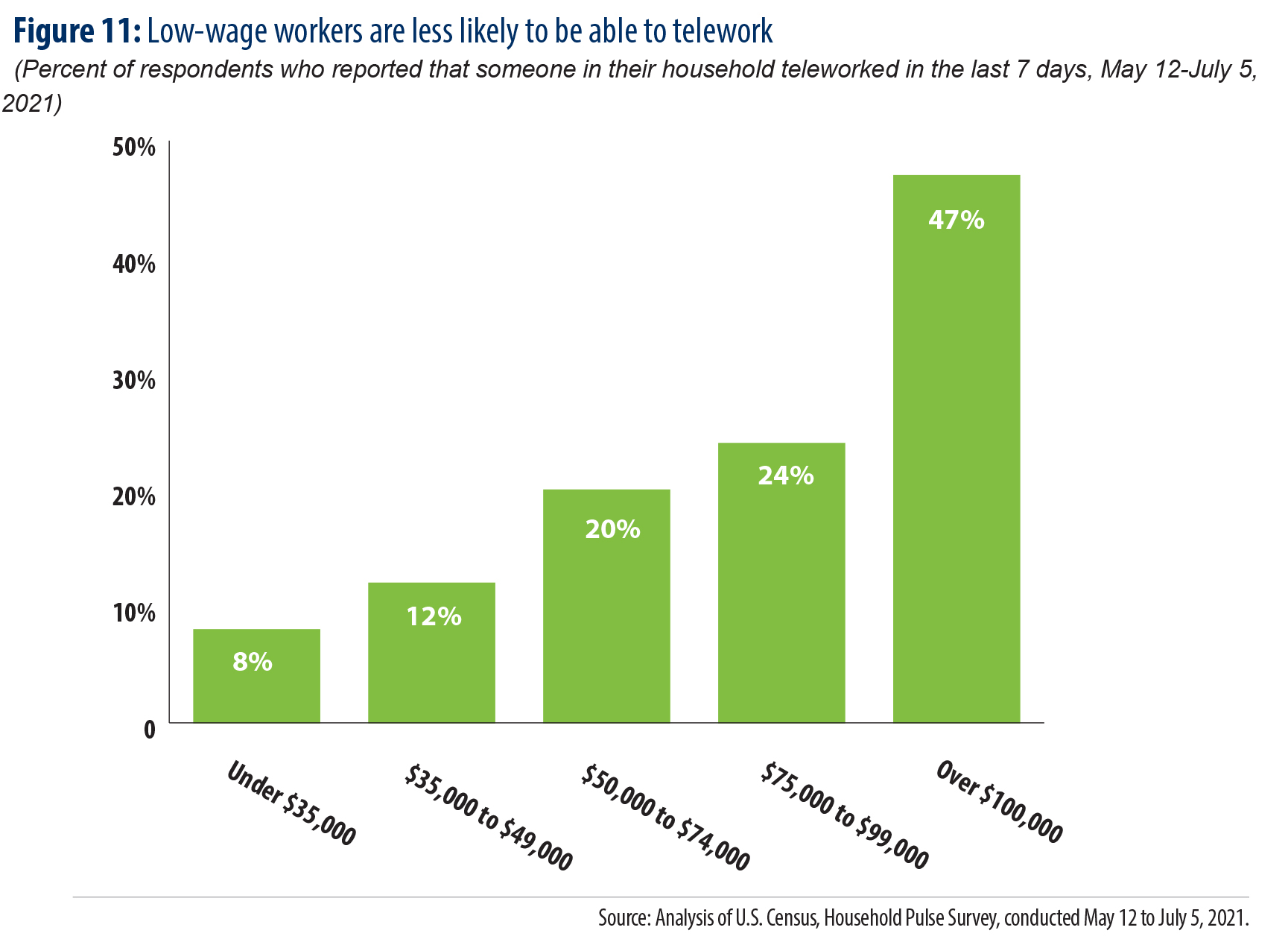 The role of affordability means that many North Carolinians outside rural areas don’t have broadband internet service at home even if they live in places that are served by broadband infrastructure, and they also face employment barriers caused by lack of access.
The role of affordability means that many North Carolinians outside rural areas don’t have broadband internet service at home even if they live in places that are served by broadband infrastructure, and they also face employment barriers caused by lack of access.
Figure 13 shows that the number of North Carolinians in urban and suburban counties without broadband internet service is comparable to the number in rural counties. (This analysis likely underestimates the portion of North Carolinians without internet service living in urban and suburban locations because county-level categories don’t account for urbanized areas within predominantly rural counties.)
Preparing people for new careers
Supporting people trying to recover from the COVID-19 recession has the potential to shift the longer-term trajectory for working North Carolinians. Expanding investments in the training and the services people need to access those opportunities, like transportation and child care, can open up new career options and put our entire economy on a firmer footing.
One of our central challenges right now is a mismatch between the experience many unemployed workers have and the skills needed for the jobs that employers are trying to fill. COVID-19 has certainly exacerbated this issue, but it predated the pandemic. Even among graduates of public post-secondary institutions in North Carolina, only
4 out of 5 had the skills and credentials that match available jobs.[25] North Carolina has a particular gap between the supply and demand for middle-skill jobs, which require more training than high school but less than a 4-year degree.[26] Jobs that required some post-high school skills training but not a 4-year degree accounted for more than half of the positions in North Carolina, but only 44 percent of workers fall into this skill level category.
It has gotten harder for people to move between jobs over the last few decades. Sophisticated workplace technologies take more specialized training, most of the best paying jobs require at least a four-year degree, and many cannot be accessed without post-graduate study. Beyond the skills, the increasing cost of living in many of the job centers of North Carolina creates barriers, particularly for low-income people trying to access better paying careers.
Growing barriers to occupational mobility pose a particular problem for younger workers whose earnings generally benefit the most from job-to-job mobility.[27] Income gains are often the greatest when people move from one industry to another, but widening differences in the required skills have made many of these kinds of shifts more difficult. This trend is not unique to North Carolina, but occupational mobility lagged behind many neighboring states in the wake of the Great Recession.
The COVID-19 pandemic has increased pressures that already were making it harder for many workers to access the best paying careers. Many companies have increased investments in automation and digitization while searching for ways to maintain productivity with less in-person work. Many industries that experienced disruptions in their supply chains, from automotive manufacturing to toilet paper, are also investing in more dynamic and flexible supply chains. All of this has increased the demand for highly skilled positions in fields like data science, logistics, cybersecurity, and artificial intelligence.[28] Accessing these kinds of opportunities will require many of the people who have lost jobs during the pandemic to complete significant retraining, which workers cannot do quickly while also trying to survive financially.
Increased retirements accelerate a challenge
Even before COVID-19 arrived, the retirement of the baby boomer generation represented one of the most consequential transitions rippling through the fabric of the U.S. economy. Businesses in many industries already fretted about how they were going to replace seasoned workers, particularly in trades that have long struggled to attract younger workers such as the specialized sectors of manufacturing and construction.
Surveys conducted in the past few months indicate a significant wave of retirements, likely fueled by COVID-19. Comparing surveys conducted last year and in the past few months, around 165,000 more North Carolinians reported being retired, a jump of more than 10 percent. Understandably, a lot of people who already were contemplating retirement decided that putting their well-being at risk by continuing to work during a global pandemic just wasn’t worth it.
Years of underinvestment in workforce training have made it difficult for people to gain the skills needed for many of the jobs that baby boomers are leaving behind. The uptick in retirements means we’re confronting overlapping challenges: recovering from the immediate shock of COVID-19 and coping with a whole generation of working people leaving the labor force.
Labor shortage concentrated in specialized, higher-wage occupations
As our state struggles to regain its economic footing, many employers have had difficulties finding employees. This kind of challenge is expected in the wake of a serious economic shock — let alone during an ongoing global pandemic — yet much of the discussion of our current labor “shortage” doesn’t consider the situation’s complexity. First of all, more people were working in June 2021 than before the pandemic, so there is no shortage of North Carolinians willing to work. While employers across industries are legitimately having difficulty filling positions, much of this is rooted in mismatches between the skills that unemployed people possess and the jobs being advertised.
Data maintained by the NC Department of Commerce shows only a handful of occupations where there are substantially more jobs available than candidates currently looking. Even more importantly, the occupations with the greatest shortage of workers tend to require extensive training and specialized skills but often pay good wages. Unlocking North Carolina’s economic potential requires helping people gain the skills needed to enter careers like engineering, sciences, health care, and management — sectors where employers face the largest challenges filling positions. Increasing equity by investing in people who face barriers to these kinds of careers is also key to fueling North Carolina’s economic growth.
Investing in the workforce can level the economic playing field
Supporting people who need training to access new careers offers potential for many communities that have been greatly impacted by economic downturns in recent decades. The level of alignment between the credentials held by college graduates and the skills required by jobs on offer is lower in many rural counties that never recovered from the Great Recession.
To be clear, this is not purely a rural-urban divide. These data only capture the differences in skill alignment for college graduates, so the level of disconnect between the skills that people currently have and the requirements of well-paying job opportunities is significantly larger than this one picture would imply. Regardless of where people live, substantially more investment in the workforce can support both people looking for a career that pays a living wage and employers desperate to find skilled workers.
Rebuilding on higher ground
COVID-19 was unforeseen, but its impact has been entirely predictable. While most of us didn’t ring in 2020 anticipating that we’d soon be facing a generational crisis, the way this pandemic has played out shouldn’t be a surprise. Like so many natural disasters, COVID-19 rushed to the cracks in our social infrastructure and created the deepest flood for people living in the lowest economic ground. If there’s a silver lining to this particular storm, it is that our deeply rooted economic weaknesses have been revealed for everyone to see.
We have the power to do better. Rebuilding from COVID-19 presents an opportunity to shore up our economic defenses and lift up communities that previously have been left in harm’s way. Helping people overcome the barriers to rejoining the labor force is the quickest way to speed our collective economic recovery, and doing it right will put us on a path to a more resilient post-COVID economy. The things we need to do right now to help people rejoin the labor force — assistance with child care, transportation, safe working conditions, training for a new career, and meeting other basic needs — are not just valuable during a pandemic; they are the foundations of a strong economy. We have the opportunity to rebuild on higher ground; now we have to muster the will to do it.
About this publication
- Patrick McHugh, Budget & Tax Center Research Manager, is a co-author of this report. Prior to joining the Budget & Tax Center, Patrick served as a Fiscal Analyst for the N.C. General Assembly. Patrick has worked on a range of economic issues, including labor force dynamics, disaster recovery, sustainable development, and workforce development.
- Logan Harris, Budget & Tax Center Senior Public Policy Analyst, is a co-author of this report. Logan has conducted mixed-methods research and supported advocacy campaigns on a range of policy issues, including economic security, housing, and the criminal legal system, with a focus on how policy change can support public health and well-being.
- Emma Cohn, Budget & Tax Center Intern, is a co-author of this report. Emma is currently an undergraduate student at the University of North Carolina at Chapel Hill, majoring in Public Policies and Global Studies.
- Christopher Chaves, Budget & Tax Center Intern, is a co-author of this report. Christopher is currently an undergraduate student at the University of Chicago, majoring in Math and Economics.
- Alexandra Sirota, Budget & Tax Center Director, contributed to this report. Before joining the Budget & Tax Center, Alexandra coordinated research on child well-being and policy analysis on family economic security at Action for Children NC. She has a broad range of experience at nonprofit organizations and government agencies in the United States and abroad.
- Suzy Khachaturyan, Budget & Tax Center Policy Analyst, contributed to this report. Suzy’s previous roles include providing social work services at a free, student-run medical clinic; informing early work of UNC’s NGACO; coordinating and conducting gynecologic cancer research; teaching math and science as a Peace Corps Volunteer; and serving as a volunteer navigator to assist consumers seeking health insurance through the ACA Marketplace during open enrollment.
- Andrea Dreier, N.C. Justice Center Communications Specialist, is the primary editor of this report. Prior to joining the NC Justice Center, she spent three years at MiracleFeet, an international health organization in Chapel Hill. In addition to her time in global health, Andrea has also worked in public and academic libraries and LGBTQ advocacy.
- Mel Umbarger, Budget & Tax Center Senior Communications Specialist, did the cover and design style for this print report. Prior to joining the Budget & Tax Center, Mel was a newspaper journalist for 15 years in North Carolina, Virginia, and Florida, where she served as an editor, multimedia and page designer, and copy editor in various jobs.
- Whitney Cork, Freelance Editor and Designer, did the copy editing and layout for this print report. Prior to her communications freelance work for a variety of companies and nonprofits, Whitney was a journalist for 25 years at the Greensboro News & Record.
[1] Alexander W. Bartik et al., “Measuring the Labor Market at the Onset of the COVID-19 Crisis,” Working Paper, Working Paper Series (National Bureau of Economic Research, July 2020), https://doi.org/10.3386/w27613.
[2] National Governors Association, “State Solutions for Supporting the Return to Work and Filling Open Jobs,” National Governors Association (blog), May 28, 2021, https://www.nga.org/center/publications/state-solutions-for-supporting-the-return-to-work-and-filling-open-jobs/.
[3] U.S. Bureau of Labor Statistics, “Labor Force Participation Rate – Women [LNS11300002],” FRED, Federal Reserve Bank of St. Louis (FRED, Federal Reserve Bank of St. Louis, January 1, 1948), https://fred.stlouisfed.org/series/LNS11300002.
[4] Leila Schochet, “The Child Care Crisis Is Keeping Women Out of the Workforce” (Center for American Progress, March 28, 2019), https://www.americanprogress.org/issues/early-childhood/reports/2019/03/28/467488/child-care-crisis-keeping-women-workforce/.
[5] Kimberly Burgess, Nina Chien, and Maria Enchautegui, “The Effects of Child Care Subsidies on Maternal Labor Force Participation in the United States,” Office of the Assistant Secretary for Planning and Evaluation Issue Brief (U.S. Department of Health and Human Services, 2016), https://aspe.hhs.gov/sites/default/files/migrated_legacy_files/171051/EffectsCCSubsidiesMaternalLFPBrief.pdf.
[6] Clive R Belfield, “Early Education in the Time of COVID-19: An Economic Analysis for North Carolina” (North Carolina Early Childhood Foundation, December 15, 2020), https://buildthefoundation.org/2020/12/new-report-child-care-crisis-cost-north-carolina-2-4-billion-yearly-before-the-pandemic/.
[7] Ibid.
[8] Leila Schochet and Rasheed Malik, “2 Million Parents Forced to Make Career Sacrifices Due to Problems with Child Care,” Center for American Progress, September 13, 2017, https://www.americanprogress.org/issues/early-childhood/news/2017/09/13/438838/2-million-parents-forced-make-career-sacrifices-due-problems-child-care/..
[9] Julia R. Henly and Gina Adams, “Insights on Access to Quality Child Care for Families with Nontraditional Work Schedules” (Washington, DC: Urban Institute, October 8, 2018), https://www.urban.org/research/publication/insights-access-quality-child-care-families-nontraditional-work-schedules.
[10] Logan Harris, “NC Needs to Invest in Child Care Assistance If We Want to Get People Back to Work,” The Progressive Pulse (blog), May 14, 2021, http://pulse.ncpolicywatch.org/2021/05/14/nc-needs-to-invest-in-child-care-assistance-if-we-want-to-get-people-back-to-work/.
[11] “Early Learning Factsheet 2019: North Carolina” (Center for American Progress, 2019), https://cdn.americanprogress.org/content/uploads/2019/09/12071730/North-Carolina.pdf?_ga=2.40485472.330758601.1627675609-1980899460.1626359973.
[12] Carranza Chabeli, “America’s First Female Recession,” The 19th (blog), August 2, 2020, https://19thnews.org/2020/08/americas-first-female-recession/.
[13] Charlynn Burd, Michael Burrows, and Brian McKenzie, “Travel Time to Work in the United States: 2019” (U.S. Census Bureau, n.d.), https://www.census.gov/content/dam/Census/library/publications/2021/acs/acs-47.pdf.
[14] Jake Blumgart, “NC: Raleigh Pushes for Permanent Fare-Free Transit,” Mass Transit (blog), July 21, 2021, https://www.masstransitmag.com/technology/fare-collection/news/21231212/nc-raleigh-pushes-for-permanent-farefree-transit.
[15] NC Department of Health and Human Services. “COVID-19 Clusters in North Carolina,” 2021. https://covid19.ncdhhs.gov/media/725/download.
[16] Stefan Pichler, Katherine Wen, and Nicolas R. Ziebarth, “COVID-19 Emergency Sick Leave Has Helped Flatten the Curve in the United States,” Health Affairs 39, no. 12 (December 1, 2020): 2197–2204, https://doi.org/10.1377/hlthaff.2020.00863.
[17] Allan Freyer, “Sick: Millions of North Carolina Workers Left out of Paid Sick Days Protections as COVID-19 Spreads” (North Carolina Justice Center, 2020), https://www.ncjustice.org/publications/sick-millions-of-north-carolina-workers-left-out-of-paid-sick-days-protections-as-covid-19-spreads/.
[18] Analysis of U.S. Census. Household Pulse. Average of survey responses collected April 4-July 5, 2021
[19] “2020 Job Seeker Nation Survey: When Change Is the Only Constant” (Jobvite, 2020), https://www.jobvite.com/wp-content/uploads/2020/05/FINAL-Jobvite-JobSeekerNation-Report1_5-11.pdf; Aaron Smith, “Lack of Broadband Can Be a Key Obstacle, Especially for Job Seekers,” Pew Research Center (blog), December 29, 2015, https://www.pewresearch.org/fact-tank/2015/12/28/lack-of-broadband-can-be-a-key-obstacle-especially-for-job-seekers/.
[20] Aaron Rieke et al., “Essential Work: Analyzing the Hiring Technologies of Large Hourly Employers” (Upturn, May 2021), https://www.upturn.org/reports/2021/essential-work.
[21] Amanda Bergson-Shilcock, “The New Landscape of Digital Literacy” (National Skills Coalition, May 2020), https://files.eric.ed.gov/fulltext/ED607391.pdf.
[22] Zoe Willingham and Areeba Haider, “Rural Broadband Investments Promote an Inclusive Economy,” Rural America (Center for American Progress, July 12, 2021), https://www.americanprogress.org/issues/economy/news/2021/07/12/501530/rural-broadband-investments-promote-inclusive-economy/.
[23] Ibid.
[24] Hilal Atasoy, “The Effects of Broadband Internet Expansion on Labor Market Outcomes,” ILR Review 66, no. 2 (April 1, 2013): 315–45, https://doi.org/10.1177/001979391306600202.
[25] “North Carolina Labor Market Alignment,” MyFutureNC – ncImpact, accessed July 21, 2021, https://dashboard.myfuturenc.org/workforce-alignment/labor-market-alignment/.
[26] National Skills Coalition, “Skills Mismatch: Lack of Access to Skills Training Hurts North Carolina’s Businesses,” accessed July 15, 2021, https://www.nationalskillscoalition.org/wp-content/uploads/2020/12/NC-Skills-Mismatch-Fact-Sheet-2020.pdf.
[27] Damien Azzopardi et al., “The Decline in Labour Mobility in the United States: Insights from New Administrative Data,” December 18, 2020, https://doi.org/10.1787/9af7f956-en.
[28] Matthew Sigelman et al., “After the Storm: The Jobs and Skills that Will Drive the Post-Pandemic Recovery” (Burning Glass Technologies, 2021), https://www.burning-glass.com/research-project/after-storm-recovery-jobs/.
 Justice Circle
Justice Circle 